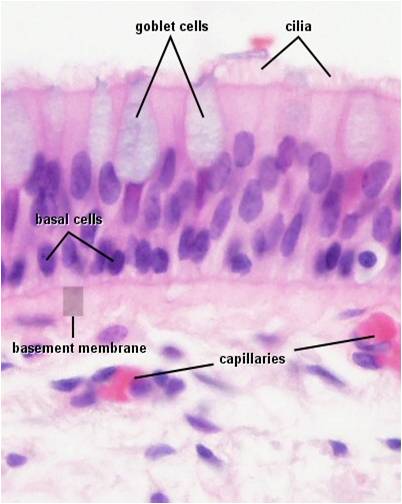Ciliated Columnar Epithelium
| As their name suggests, ciliated columnar epithelial cells are rectangular in shape and have between 200 to 300 hair-like protrusions called cilia (see Figure 1). The mitochondria are found toward the apical region of the cell while the cell nuceli are found towards the base and are often elongated. Cells are interconnected via desmosomses and tight junctions, creating a semipermeable membrane that is more selective that membrane found in other types of cell. |
|
Ciliated columnar epithelial cells are found mainly in the tracheal and bronchial regions of the pulmonary system and also in the fallopian tubes of the female reproductive system.
Ciliated columnar epithelium in the pulmonary system is interspersed with goblet cells that secrete mucous to form a mucosal layer apical to the epithelial layer (see Figure 2). The rowing-like action of epithelial cilia work in tandem with goblet cells to propel mucus away from the lungs, preventing particulate matter from causing infection (see Video 1).
Video from http://www.youtube.com/watch?v=miEEluVlemQ&feature=player_embedded.
Video 1. Role of ciliated columnar epithelial cells in the lungs.
A study by Lawson et al. (2002) concluded that ciliated cells play a critical role in the repair of distal airway injury.While these pulmonary epithelial cells are traditionally believed to be terminally differentiated cells that do not divide, data from Park et al. 2006 suggest ciliated cells undergo morphological transitions from squamous to cuboidal to columnar forms as the bronchiolar epithelium is restored after tissue damage, indicating differentiation potential.
 |
 |
image from: http://www.lab.anhb.uwa.edu.au/mb140/corepages/epithelia/images/trachea041he.jpg Figure 2. Microscopic view of tracheal ciliated columnar epithelium. |
image from: http://health.allrefer.com/health/aging-changes-in-the-lungs-respiratory-cilia.html Figure 3. Ciliated columnar epithelial cell in the lungs. |
Ciliated columnar epithelium at the entrance of the fallopian tubes prepare the unfertilized ovum for fertilization by aiding in the transportation of the ovum from the ovaries to the uterus.
Video from: http://www.youtube.com/watch?v=nLmg4wSHdxQ&feature=player_embedded
Video 2. Ovulation and the role of ciliated columnar epithelial cells in reproduction.
http://health.allrefer.com/health/aging-changes-in-the-lungs-respiratory-cilia.html
http://www.lab.anhb.uwa.edu.au/mb140/corepages/epithelia/images/trachea041he.jpg
http://www.youtube.com/watch?v=miEEluVlemQ&feature=player_embedded. Functions of Cilia and Goblet Cells.
http://www.youtube.com/watch?v=nLmg4wSHdxQ&feature=player_embedded. Ovulation.
Alberts, B., Johnson, A., Lewis, J., Raff, M., Roberts, K., & Walter, P. (2002). Molecular biology of the cell (4th ed.)
Mallery, C. Animal structure and function.http://www.bio.miami.edu/~cmallery/150/physiol/physiology.htm
Ownby, D. C. The uterine tubes.http://instruction.cvhs.okstate.edu/histology/fr/HiFRp12.htm
Proud, D. (2008). Pulmonary epithelium in health and disease Wiley.
